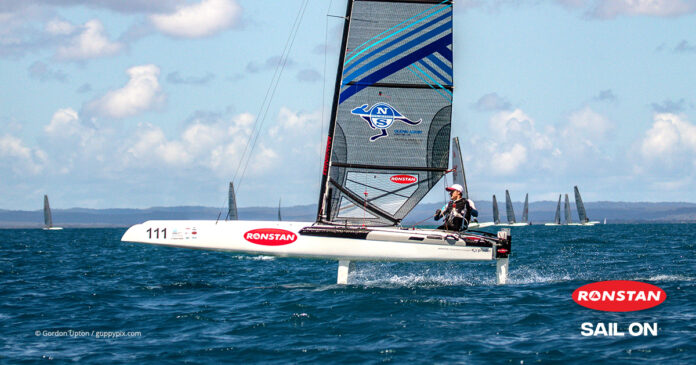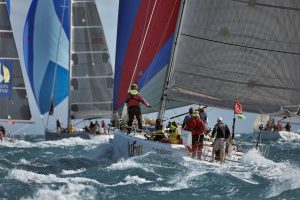

ph. Andrea Francolini
Tips From Sailing Legends – below are just a few that I found to be really useful.
When you’re racing and you feel slow, what’s the first thing you do to change? Augie Diaz
What I try to do is ease.
Generally, I’m a pincher, so when I’m going slow, the first thing I do is ease the sails a little bit. I try to put the bow down which gives you a good feel for what you know you have to do next.
I think to be disciplined about feeling slow, then you ease the sails out a little bit and put the bow down a little bit and get flow.
The biggest problem for pinchers is that you lose flow on the blades. Not just the blades in the water, but also on your foils above, the sails. It’s all about flow. It’s like flying.
Stand up as high as possible and look around – Glenn Ashby
Stand up high on the boat. You don’t see a huge amount of people doing this very often.
Standing up gives a really different perspective of actually being able to look far at the course. We all know that the Earth’s round and the higher you get up the further you can see.
Getting an elevated position, even if it’s just standing up in your dinghy, makes a really big difference in what information you can process.
5 to 15 minutes before the start, get up and have a good look around, observe other boats’ angles. If they’re doing a split, or they’re doing a line-up, don’t keep sailing around randomly, just stop and watch.
Observing other guys doing their line-ups from both sides of the course, gives you a good indication of how shifty it is.
Stopping and observing is a really important thing that not a lot of people do well.”
Internalize the fact that everyone racing has as much a right to a good finish as you do – Chris Snow
Most fleets develop a pecking order of sorts.
Joe usually is near the top, Jim is in the middle and Jess who is less experienced towards the back.
As you get better you might find yourself thinking that some of your competitors are easy marks. You might even look at the entry list and think to yourself “I’m for sure better than Jess”. I’ll probably be in front of her today”.
From a mental control point of view, this type of thinking is dangerous. At some point or another Jess will be in front of you. In the course of a normal race, she might tack on you or take away your lane of clear air.
Should You Ever Reach The Layline Far From The Mark? – Dave Dellenbaugh
As a rule of thumb, no. It seldom pays to be on the layline when you can barely see the mark (or even when you’re closer than that). But like all such rules, this one can be broken occasionally.
Most sailors have at least one good story when they got to the layline very early and very far from the mark and made out like bandits.
Here are some situations when this may work again in the future:
• One side of the course is very favoured and you have to be there.
Sometimes you are sure that one side of the course is a lot better.
Maybe it has been paying off on every beat so far, and the farther you go to that side the better you will do.
In this case, you can’t worry about what will happen if you get to the layline too early. Just head for that corner and do your best. Even if you overstand and sail in bad air all the way to the mark, you will still probably round ahead of boats that went the wrong way.
• You are in first place and covering most of the fleet toward the favoured side.
When you are leading the race, you don’t have to worry about sailing in bad air on the layline. You just have to realise that once you get to the layline you won’t be able to play the shifts any more.
As long as you are confident that you are going the right way, and as long as most of the other boats are going there with (behind) you, it’s usually OK to reach the layline early.
• You’re near the back of the fleet and willing to take a large risk to catch up.
Sometimes the only way to make a big enough gain is to get lots of leverage on the rest of the fleet. This usually means getting to one of the laylines pretty early.
Even if you get tacked on or this turns out to be the wrong side, you don’t have much to lose.
First weather leg – Matt Fisher
We have gotten away from trying to guess which side is favoured. We spent 3 or 5 years trying to determine which side will be favoured and we weren’t very good at that.
Sure, in light air, especially in very light air, we will look upwind with 2 minutes to go and try to see if we can tell if there is any more pressure on one side or another.
But our “strategy” in 90% of the races is to start near the favoured end and sail the shifts.
Sure we end up on a side and have sailed lifts out to a side when we are trying to get back to the middle but we do not try to guess which side is favoured.
Yes, often one side will come in and often the people that win from that side race will either say they sailed up the middle or they saw something on that side, but we sail shifts as much as we possibly can.
Stay in phase on the beat – Mike Considine – UK Sails
Part of sailing the shortest distance is always being on the favoured tack. Identify shifts upwind. Sometimes following everyone is okay if you are on the favoured tack and in clear air.
Use the fleet ahead of you to read the shifts, watching the angles the lead boats are sailing. Anticipating the shifts can increase your leverage.
Being set up to be on the inside of the next shit will pay big dividends. The lead boats are usually tacking on the shifts, watch them and their angles to the mark.
Know when to bang a corner & not (Increased leverage): With persistent shifting conditions or large immediate shifts, it may be okay to hit a side hard to make a big gain. Significant wind increases on one side or the other can be the reason to bang a side.
Stream the jib leech telltale – Steve Hunt
Most jibs perform well when they’re tight enough that the top leech telltale stalls every once in a while.
A few more ratchet clicks of trim, and the telltale will stall much more—50 per cent or more. A little ease, and it’s streaming 100 per cent of the time.
The sweet spot for a jib is just a touch in from full flow—95 per cent. At this trim, your jib will be as tight as possible without stalling airflow through the slot. This will help your speed and pointing.
If you’re not going well upwind, jib trim is one of the first places to make an adjustment.
Stay focused
This may sound obvious, but no one can give 100 per cent concentration all the time – and even just a short lapse at a critical time can cost several places.
As well as good nutrition, make sure your conversation doesn’t wander away from the race and that everyone is tuned in on the run-up to important manoeuvres.
This is particularly important in the latter parts of a race – many crews will be flagging, so those who stay focused on the job can make good gains relative to other boats.

